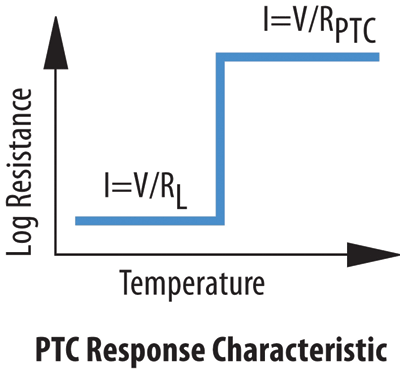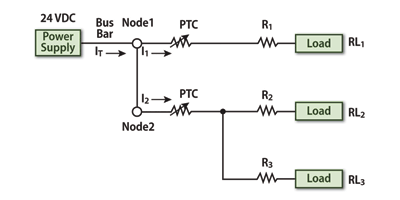Resettable fuses crucial for robust circuit protection
The variety of resettable fuse devices makes it easy to incorporate adequate overcurrent protection
BY BRIAN AHEARNE
Bourns, Riverside, CA
http://www.bourns.com
Circuit protection has become a crucial design consideration to protect sensitive applications against overcurrent conditions. In most applications, overcurrent and overtemperature conditions are an everyday reality that can lead to costly repairs of field failures. Therefore, it is essential that every time a user plugs in, operates or leaves a device unattended, a mechanism is in place to ensure that no above-range current causes damage to the very circuits that allow that device to work. Resettable fuses are a popular circuit protection solution for a wide range of applications, especially those that are not easily accessible for repair or replacement.
Widely available, a resettable fuse is a passive electronic component and is also known as a polymeric positive temperature coefficient device (PPTC) that has been specifically designed to protect against faults in electronic circuits. Resettable fuses have the ability to both protect against dangerous currents and then cycle back to a conductive state after the dangerous current is removed, acting similar to a circuit breaker. This allows the circuit to function again without opening the device or incurring the time or resource costs to replace it. In addition, to demonstrate the importance of robust circuit protection, some interface standards even require resettable overcurrent protection.
Because circuit protection is such a crucial consideration for many of today’s designs, and resettable overcurrent protection is being more widely adopted, it is a good exercise to understand how resettable fuse technology works and some of the latest circuit protection advancements. The latest resettable fuse products feature increased performance, allowing the device to handle higher currents and voltages while improving its resistance stability.
How resettable fuses work
Resettable fuses exhibit a positive temperature coefficient (PTC) effect when heated. As the PTC heats due to current or ambient temperature, the device material resistance increases and the unique material matrix expands. This is the result of the material transforming from a crystalline phase to an amorphous phase. This expansion increases the impedance from low to high, effectively creating an open circuit with a small leakage current. When a circuit trips, resistance increases by multiple orders of magnitude. It is at this transformation of the material from low resistance to high resistance that a resettable fuse device trips, allowing the fuse to protect the load from an overcurrent event within rated limits. Once the current is removed, the material cools and returns to its highly conductive, low-resistance crystalline state.

Fig. 1. PTC response characteristic.
It is crucial for designers to remember that after the device has tripped and the current is removed, the device must be power cycled to reset. If the power is left on following a trip event, the device will not reset on its own. The proper method for resetting the device is to remove the power source, typically within one or two seconds. Once the power source is removed, the device simply resets itself.
Next-generation designs
As resettable fuses expand in size when they trip, it is critical not to restrict their ability to expand. The more rigid the packaging around the resettable fuse element, the less its ability to expand and contract. If the resettable fuse is constrained from expanding during a trip event, the fuse will have a reduced ability to return to an effective low resistive state. Some next-generation resettable fuse designs are now manufactured with unique packaging structures that allow the devices to easily expand and contract with a minimum amount of restrictive elements.
Selecting the appropriate resettable fuse
The operational life of a resettable fuse device depends on the surge, duration and spike of the current to which it is exposed in a given system. It is important to note that because a larger chip package results in larger thermal mass, the material heats more slowly than in a smaller package causing a slower trip time. A smaller package trips faster, within a fraction of a second. The proper component must be chosen to protect the load for a given design based on the maximum allowable trip time.
When numerous loads are sharing the same power supply, it is advantageous to allow each load to operate independently or in subsets instead of hinging the operation of every load on the system current condition. It is possible to utilize multiple PTCs for multiple nodes sharing a power supply (for example, ganged USB ports), as shown in Fig. 2 .

Fig. 2. General PTC example.
Selecting the appropriate resettable fuse can be narrowed down to three short steps:
First, the operating voltage of the application circuit must be verified (for example, 5.5 V). With this value, designers can refer to datasheets of a particular supplier’s resettable fuse models and select a device that has a maximum voltage rating (often referred to as VMAX ) higher than the circuit voltage (for example, a device of VMAX 24 V would be >5.5 V). This design step ensures that the PTC can operate effectively within the operating voltage of the circuit.
Second, determine the operating current of the circuit (for example, 500 mA). With this information, refer to the hold current (IHOLD ) in the resettable fuse datasheet and select a model with an IHOLD value, higher than the operating current (for example, for a 750-mA device, it is >500 mA). This helps ensure that the PTC will not nuisance trip in the application.
Finally, verify the ambient temperature of the circuit (for example, 40C) and then using the thermal derating chart on the datasheet, select a PTC model that has a higher IHOLD value than the circuit operating current, at that ambient temperature (for example, 750 mA at 40C >500 mA at 40C). These steps can help simplify the product selection process. However, other specifications should also be reviewed, such as device resistance, device time-to-trip, and mechanical dimensions that will further help establish the optimal solution for the specific application.
Overcurrent protection is critical for the lifespan of most electronic systems. Next-generation resettable fuses meet the standards and requirements for secure and reliable overcurrent protection within rated limits. Once system requirements are defined and circuit analysis has determined the operating parameters, selecting the right fuse for a specific design can be rather simple.
Today’s resettable fuse products offer a wide range of speed, voltage, and current limits enabling designers to select a circuit protection solution to match their application. The variety of resettable fuse devices also makes it easy to incorporate adequate overcurrent protection into a design, even those with smaller footprints or space-constrained layouts. ■
Advertisement
Learn more about Bourns





